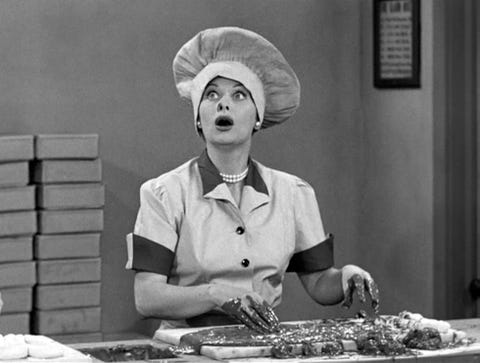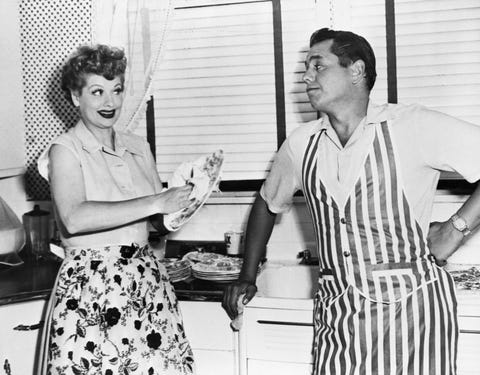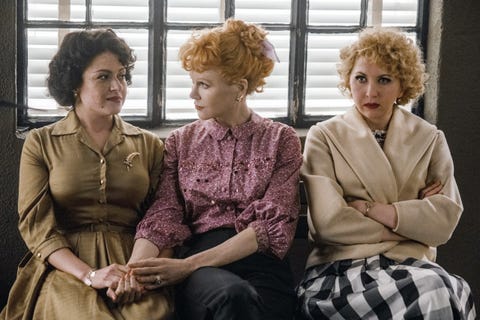I Love Lucy and its stars not only set the tone for, but defined the family sitcom. Lucille Ball and Desi Arnaz dominated the 1950s as Lucy and Ricky Ricardo, and their reign as TV’s funniest married couple lasted long after their IRL union had come to an end—thanks to reruns, another innovation of their production company, Desilu. Theirs is a story that has long held the public’s fascination, the latest evidence of which is the new Aaron Sorkin biopic, Being the Ricardos (out now in theaters and on Prime Video), which focuses on one scandalous week in the life of Ball and Arnaz.
Even before its release, Being the Ricardos sparked headlines, thanks to an outcry on social media when Nicole Kidman was cast as Ball. The criticism grew so heated that Kidman considered quitting before Sorkin stepped in, as she explained in a recent appearance on Live with Kelly and Ryan: “Everyone thinks I’m not right, so I’m going to try and sidestep this.” Pap shots of Kidman filming alongside co-star Javier Bardem did little to alleviate concerns, as the casting of Spanish actor Bardem as Cuban icon Arnaz was equally contentious.
Still, Being the Ricardos was able to push forward largely due to the support of Ball and Arnaz’s daughter, Lucie Arnaz, who’s a producer on the film and has endorsed Sorkin’s vision regarding her famous parents. But even she wasn’t entirely convinced all of Sorkin’s choices made sense: In particular, Sorkin told The Hollywood Reporter that Lucie had reservations about his choice to depict three defining moments in her parents’ relationship all during one production week. Ball’s second pregnancy, tabloid stories about Arnaz’s rampant infidelity, and accusations that the I Love Lucy star was a Communist did all take place—but not within a six-day time frame.
Ball and Arnaz managed to break free of the studio system and gained second-act stardom when they embraced the new medium of television. The couple’s passionate union and its subsequent breakdown are integral to their story, and Sorkin’s movie does do some justice to Ball’s intense work ethic. But where does Being the Ricardos capture the reality of what happened, and where does it fall short? Let’s break down a few key questions.
Was Lucille Ball really “Queen of the B Movies”? (Yes.)
During one animated moment in Being the Ricardos, Lucy makes it sound like she entered the world of showbiz as a young adolescent—but that’s not strictly true. Yes, Ball had dreamed of becoming an actress since she was a teenager, but she didn’t arrive in Hollywood until she was in her 20s, when in 1933 she was cast in Eddie Cantor’s Roman Scandals as one of the legendary Goldwyn Girls. Before this, at the age of 17, she briefly attended the same New York City drama school as Bette Davis. Ball recalls this miserable experience in her memoir, Love, Lucy, as her mother was told she “didn’t have what it takes to become an actress.” Stints modeling for fashion maven Hattie Carnegie (whose clients included Joan Crawford, Gloria Swanson, and Joan Bennett) proved to be invaluable as she picked up innumerable tips that would later inform her acting work. It was also at this time that she dyed her hair from mousy brown to icy blonde to match the starlets of the era, though another hair color would later define her look.
“I’m a contract player at RKO. I play the roles I am told to play. My career has gone as far as it is going to go. It’s hitting cruising altitude,” Kidman’s Lucy explains to Desi in Being the Ricardos. He thinks she should be a movie star, not the “second lead in Too Many Girls,” but she’s stuck in roles that the real Ball referred to as Dance Girl, Dance’s “wisecracking stripteaser.” Critics often hailed her scene-stealing performances, but it was tough to break out of the typecasting box in the studio era—which is how Ball earned the “Queen of the Bs” nickname that is referenced in Being the Ricardos.
“An actress gets typed and her real personality is lost in the shuffle,” Ball laments in her memoir about this period. Her physical comedy prowess wouldn’t be truly utilized until TV came calling.
Did she lie about her age? (No, not as often as the film depicts.)
In her memoir, Ball calls The Big Street “the biggest hit of my film career.” But despite its success, the film also led her to leave RKO Pictures production company for MGM in 1942. Being the Ricardos portrays this as a forced decision, but in reality Ball had agency.
In the film, when Lucy is called into RKO executive vice president Charles Koerner’s (Brian Howe) office, the shock is palpable when she’s informed the company is letting her go. In real life, Ball described this as an amicable meeting, where Koerner offered to share her contract with either MGM or Paramount, and “I chose MGM because they were tops in musicals,” Ball writes. MGM would be the studio where hairstylist Sydney Guilaroff would dye Ball’s hair its soon-to-be signature flame-red on Du Barry Was a Lady.
The bitterness of the Sorkin-written scene is amplified when Lucy’s age is mentioned: Koerner says that the actress is actually 39, though she’s been trying to pass off as 35. (This meeting took place in 1942, which would have actually put her at 31.) While Hollywood performers did fib about their DOB during this era (most notably, Joan Crawford routinely shaved digits), Ball quips at the start of her autobiography that “everybody knows my birth date because I told the truth when I came to Hollywood.” In truth, the only place where Ball is known to have lied about her age was on her marriage license with Arnaz: The document said she was 26 (she was 29) and Arnaz was 25 (he was 23).
Was Lucy and Desi’s relationship that explosive? (Yes.)
Very explosive. “I fell in love with Desi wham, bang! In five minutes,” Ball describes. This is one area that Being the Ricardos gets right, though the film skews some details: Their first meeting was in the RKO commissary, not on a soundstage, and they didn’t sleep together after their first date—it was their second.
A familiar pattern would follow. The couple argued incessantly on the phone when working in different cities before passionately making up in-person. “Marrying Desi was one of the boldest things I ever did,” Ball said more than 20 years after their spontaneous 1940 wedding. Friends didn’t think it would last more than six months, but they made it last longer; Ball didn’t file for divorce until after four years. California law stated there couldn’t be a reconciliation between a couple within a year before the paperwork could be finalized, but Ball and Arnaz didn’t even make it 24 hours before reconciling. Ball had to eat “$2,000 in fees for the divorce I never got,” which she said was “worth it.” Considering what they would go on to create, we have to agree with her.
Being the Ricardos skips over this drama, but it does portray the work conflicts that signaled the couple’s marital bliss was short-lived. The pressure of being separated by Arnaz’s touring bandleader career (and his proclivity for sleeping with sex workers) while Ball was working in Los Angeles took its toll. When they were both in the same city, their differing schedules meant dates at dawn, which Sorkin’s biopic does depict. Even before Desilu productions had transformed TV comedy, this hybrid name is what they called their first home together; they were inspired by silent movie icons Mary Pickford and Douglas Fairbanks, who’d called their own estate Pickfair.
Was I Love Lucy really a marital Band-Aid? (Yes.)
Here, Being the Ricardos nails the truth: Television offered a second act to not only the couple’s stardom, but also their marriage. “You know I did this show so Desi and I could be together. I had no idea it was going to be a hit,” Kidman’s Lucy tells co-stars Bill Frawley (J.K. Simmons) and Vivian Vance (Nina Arianda) after she hits a breaking point. Both parts of this statement are true: When Ball was offered the chance to turn the radio series My Favorite Husband into a half-hour TV series, she agreed, but only if Arnaz could play her husband.
The battle to get CBS to agree to this casting was almost as fierce as the couple’s marriage. Showrunner Jess Oppenheimer (played by Tony Hale in the film) recalls in his memoir, Laughs, Luck… and Lucy that CBS was concerned that “nobody would believe that an all-American redhead like Lucy was married to someone like Desi.” (Even though Ball was married to Arnaz.) The film goes in harder when Lucy is told, “We cannot have an all-American girl married to a man who isn’t American.” (Desi was, in fact, an American citizen; he just wasn’t white.)
CBS did relent after the couple proved they could sell out theaters across the U.S. and earn rave reviews; the company didn’t want NBC buying the series from under their noses. The show was a hit, but as Being the Ricardos explores, the pregnancy storyline did indeed cause consternation from CBS executives until sponsor Philip Morris showed support. But the timeline in the film is scrambled: By the time the movie is set, Ball had already had her second child, and the other major crisis threaded through the “compound fracture of a week” didn’t occur until two years later. Yes, notorious tabloid Confidential ran a front-page story entitled “Does Desi Really Love Lucy?” which caused tension on set—but it definitely didn’t happen the same week as the Red Scare.
Was Lucy a Red? (No.)
Nine months after the birth of Little Ricky (and Desi Arnaz Jr.), I Love Lucy almost came to a shrieking halt when Walter Winchell ended his Sunday night radio show with a blind item that asked, “What top redheaded television comedienne had been confronted with her membership in the Communist party?” Everything Being the Ricardos depicts regarding why Lucy registered as a Communist in 1936 is accurate, as is the fear that mere association could end your career if the House of Un-American Activities Committee (HUAC) came calling.
The events of the week as depicted in the film are dialed up for drama, however. The Los Angeles Herald-Express—with its headline in 4-inch red ink—did come out on the day of the Friday show taping, but it was the noon edition, so by the time the audience filed in, everyone knew about the Communist accusation. There was no call to J. Edgar Hoover, and a press conference hosted by HUAC chairman Donald L. Jackson at 6 p.m. (two hours before showtime) cleared Ball’s name. The actual speech Arnaz gave in place of his usual audience warmup spoke emotionally about his wife and his experience in the country he was forced to flee as a teenager due to Communism. Still, the real-life crowd responded in a similarly effusive manner as the one in Being the Ricardos (minus the Hoover theatrics) when Arnaz introduced his co-star with a joke fit for Ricky Ricardo: “Now I want you to meet my favorite wife, my favorite redhead—in fact, that’s the only thing red about her, and even that’s not legitimate—Lucille Ball!”
Were Lucy and Vivian Vance real-life frenemies? (Not exactly.)
While Vance and on-screen husband William Frawley downright loathed each other, the friendship between Ball and Vance was more complex than is depicted in Being the Ricardos. It’s likely the pair were close (Lucie Arnaz refers to Vance as family), but in an industry predicated on looks, they were often put at odds. Although Vance and Ball had only two years between them in real life, Vance’s character of Ethel Mertz was characterized as much older. Ball mentions that Vance “went along gamely” with the dowdy clothes and limited eye makeup, but Being the Ricardos points to a real tension between the friends.
“Most American women look like you, not me. They want to see themselves on television,” Kidman’s Lucy tells Vivian after she vetoes a striking red dress her co-star hopes to wear. In a later scene, she unsubtly tries to prevent her from dieting because “it’s not good for Ethel.” Costume-wise, Ball didn’t want either character to have closets that didn’t reflect their middle-class income, and both women wore repeat looks throughout the series to ensure a level of relatability.
“I’d express my frustrations by getting mad. Vivian was a tower of strength in such circumstances; she would intuitively guess what was wrong and then analyze it,” is Ball’s description of the co-stars’ working dynamic. It’s no wonder, then, that when the famous redhead returned to TV in 1962 for The Lucy Show, her best friend was at her side. “I refused to even consider being in a continuing series without Vivian,” Ball recalled in her memoir. By this point, Vance had left one very bad marriage and settled down in Connecticut with literary agent John Dodds. “Her loyalty to me—and a very hefty paycheck—won her back to my side,” Ball said of this reunion. The pair remained close until Vance died in 1979.
Did Being the Ricardos cover the whole story of Lucy’s lasting legacy? (Absolutely not.)
It’s true that Ball’s legacy is inextricably linked to Arnaz. They are frozen in time as the Ricardos on that Desilu soundstage—which is how Being the Ricardos leaves the pair— and they remained close even after they’d both remarried. “They stayed good friends to the bitter end,” Lucie Arnaz has said about her parents’ enduring partnership; the two even shared a divorce lawyer.
Still, Sorkin’s film ends with a simple postscript noting the couple divorced in 1960 (Ball filed the day after their last episode as Lucy and Ricky aired), but neglects to mention Ball’s lasting impact on the pair’s production company, Desilu.
In 1957, Arnaz bought RKO studios while on break from rehearsals of The Lucy-Desi Arnaz Comedy Hour. Two years after their divorce, for reasons relating to his health, Arnaz quit as Desilu president and Ball took over the company to become the first woman in charge of a major television studio. In her third act, Ball juggled headlining hit TV shows in the 1960s with corporate and creative responsibilities. The latter included green-lighting both Star Trek and Mission: Impossible—even though she was told they were too expensive—and she continued this role until 1968.
After making Desilu profitable again, she sold her shares for a cool $17 million (worth $130.6 million in 2021) to Gulf+Western, who rebranded the company as Paramount Television. In 1986, a visibly emotional Ball received the Kennedy Center Honor; the occasion was all the more poignant as Arnaz had died five days before. While the company she started with Arnaz no longer exists, the mark they made on TV history is indelible, and Ball’s pioneer status goes far beyond her role as Lucy Ricardo.
This content is created and maintained by a third party, and imported onto this page to help users provide their email addresses. You may be able to find more information about this and similar content at piano.io



